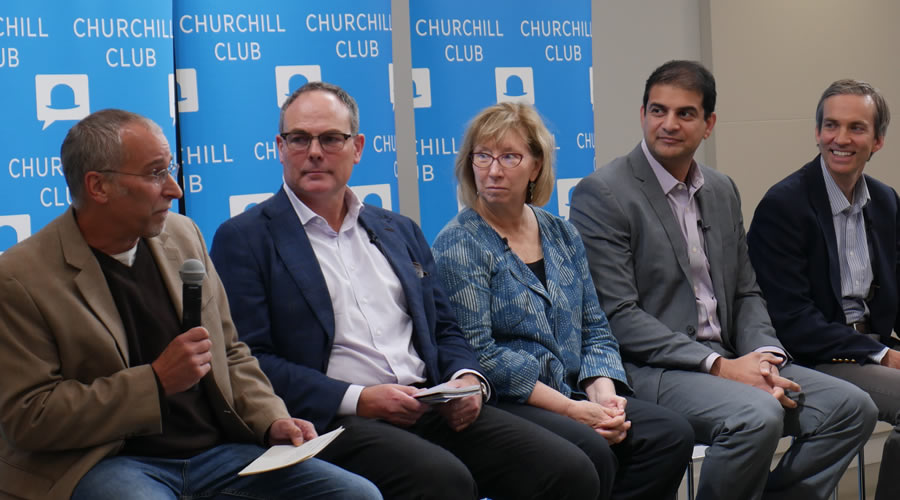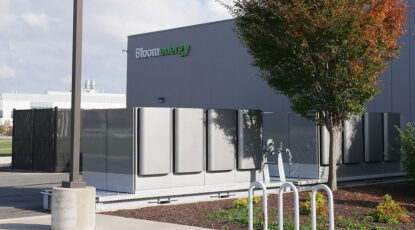Are microgrids creating energy ‘haves’ and ‘have-nots’? Does the trend towards decentralized electricity generation threaten the stability of the centralized grid itself? What’s the value of a microgrid anyway?
These were some of the questions Greentech Media editor Eric Wesoff posed of panelists taking part in Churchill Club’s ‘What’s the Future of Microgrids?’ event on October 4th. But before the panel weighed in on pros and cons, Wesoff asked them to offer a definition.
“What is a microgrid? It’s the migration of centralized power to more distributed energy” explained Tom Chadwick, CEO of GI Energy, a designer and installer of microgrids that is affiliated with Shell.
Or to put it another way: “We define a microgrid as a (power generation) system that can island from the grid for days at a time” said Asim Hussain, VP of Customer Experience at Bloom Energy.
It is this ability to operate independently of the grid that leads some to think of microgrids and the centralized grid as being in competition. (Not everyone agrees with that point, but more on that later).
In the 90s, GI Energy’s Chadwick worked in the telecoms industry, and he likens the potential impact of microgrids to the disruption caused to fixed line operators by cell phones.
A similar disruption of electricity utilities worries Sally Benson, Director of the Precourt Institute for Energy at Stanford University. “I have a real concern about disinvestment in centralized power and its impact on the grid,” she said. “I mean, would you ever want to be garbage-independent? Or sewer-independent?”
“Will the grid be just for the people who can’t afford microgrids?” echoed Eric Wesoff.
“I’m not against microgrids” clarified Benson, and neither, it transpired, were the other panelists, prompting Wesoff to ask: “What is the value of a microgrid?”
Energy resilience – a defense against escalating grid outages – was highlighted as one use case.
GI Energy’s Chadwick described a project his firm is working on in San Francisco’s Hunters Point, a decommissioned shipyard area that is now one of the city’s up-and-coming neighborhoods. “We’re building a sort-of-a-microgrid that uses mostly solar and heat pumps for community heating” he said. “It includes smaller pockets within the community that could sustain themselves in the event of a grid outage.”
Asim Hussain of Bloom Energy highlighted a microgrid that Bloom Energy built for the City of Hartford, Connecticut, after a catastrophic storm caused a widespread power outage in the city in 2011. Hartford’s microgrid leverages fuel cells to provide 24/7 power to critical community resources, including: an elementary school, a library, a senior center, and a gas station. These can all continue to operate in the event of a grid outage.
Neither of these examples did much to assuage concerns that microgrids are competing with the grid. “Utilities don’t love microgrids,” said Wesoff. “Islanding creates instability, as well as taking load away. Don’t you guys need to work well with utilities?”
Mark Perutz, a venture capitalist with DBL Partners, suggests there may be a lot of opportunity for utilities and microgrid providers to collaborate rather than compete.
He highlights that one of his investments, Advanced Microgrid Solutions (AMS), has deployed a microgrid that is helping to stabilize the local grid operated by Socal Edison in Orange County, California. AMS has installed Tesla batteries at Irvine Ranch Water District which help to reduce the district’s demand at peak times. The batteries can also be discharged to provide grid-balancing support when needed.
Hussain highlighted another instance of a microgrid and a utility work in concert. “In New York, Con Ed was facing enormous growth in demand in Brooklyn and Queens. That growth seemed very likely to lead to blackouts and brownouts this summer,” he said. “Instead of spending more than a billion dollars upgrading the grid, Con Ed gave incentives to customers to adopt on-site generation such as solar and fuel cells to reduce demand. It’s a good example of a hybrid model that is working.”
Perutz agreed: “Utilities may be some of the best customers for microgrids, and especially batteries.”
“Real estate developers are also very interested in microgrids,” added Chadwick. “They can save money by adding a microgrid versus getting new wires deployed to a site. They help real estate builders avoid deploying capital on non-core business areas.”
Noting that most of the panelists had some relationship with traditional energy companies (either as a source of funding, or as a source of fuel), Wesoff asked the question: “Is there always going to be a need for a base load fossil fuel in a microgrid? Something other than solar?”
“It’s going to be very hard with a solar/battery pairing to be totally grid independent,” replied Sally Benson, adding that Precourt Institute research across five states from Alaska to Florida found that even in the sunniest states, there would be about an 18% shortfall in supply with the solar/battery combinations.
Perutz countered, arguing that fossil fuels may eventually not be needed: “If money was no object, you could do it. But current battery technology has to be replaced every four-to-six years.”
The microgrid landscape could look very different in four-to-six years from now. Research firm Technavio estimates the microgrid market will grow to reach $23.1 billion by 2022, growing at a CAGR of 9.7% from 2017’s $14.6 billion. And what can we expect of the central grid in that time frame?
“Say you have a solar-powered microgrid and you only need 15% of your electricity from the grid. If solar has a bad day, we are all going to need a lot of power from the central grid, but only for a short period of time. Who’s going to pay for all of that back-up requirement?” asked Sally Benson, adding that until battery storage prices decline very substantially, batteries won’t be the answer.
Chadwick concluded that we should be optimistic about the future for utilities too.
“Demand (for electricity) is going to grow. We’re going to need more air conditioning. We’re going to drive more EVs. We’re going to need more power.”
Picture caption: L-R Eric Wesoff of Greentech Media, Tom Chadwick of GI Energy, Susan Benson of Stanford University, Asim Hussain of Bloom Energy, and Mark Perutz of DBP Partners.



